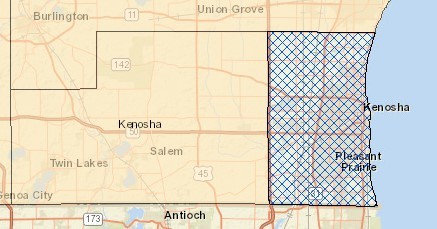Think of clean air enforcement over SE Wisconsin and Northern Illinois like you would a gerrymandered map, where partisanship, favoritism and insider influence skew unscientifically drawn lines.
You may remember that Walker won from then-EPA Administrator Scott Pruitt a controversial exemption from toughened Federal clean air attainment standards in the Lake Michigan shoreline counties.

The immediate impact of the change: Foxconn would be able operate without having to spend a relative boatload of money to meet air pollution standards which were being toughened nationally.
The Wisconsin DNR said Monday that non-attainment for ozone pollution in Eastern Kenosha County had been reclassified from "moderate" to "serious," and emission permits might have to be reworked.
Bottom line: clean air enforcement in SE Wisconsin now takes place under a politically-drawn, crazy quilt map.
As if air pollution didn't cross county lines.
You may remember that Walker won from then-EPA Administrator Scott Pruitt a controversial exemption from toughened Federal clean air attainment standards in the Lake Michigan shoreline counties.

The immediate impact of the change: Foxconn would be able operate without having to spend a relative boatload of money to meet air pollution standards which were being toughened nationally.
"Unfortunately, the people living around Foxconn in Racine and Kenosha counties in Wisconsin are the big losers," said Michael Mikulka, president of American Federation of Government Employees Local 704. "They will have to breathe in more air pollution every day because of Pruitt's gift to the governor...."
In addition to completely exempting Racine County from the smog standards, Pruitt scaled back the EPA staff recommendations for other parts of Wisconsin, leaving only strips of land along Lake Michigan in Door, Kenosha, Milwaukee, Ozaukee, Sheboygan and Manitowoc counties on the list of areas that need to take more aggressive steps to improve air quality.Now it seems as if those "aggressive steps to improve air quality" are about to begin.
The Wisconsin DNR said Monday that non-attainment for ozone pollution in Eastern Kenosha County had been reclassified from "moderate" to "serious," and emission permits might have to be reworked.
The reclassification will take effect September 23, 2019 and will affect how air permitting is conducted in the eastern portion of the county. DNR is working with impacted facilities to explain any changes to the permitting process and to adjust existing permits as needed.
Foxconn easily won air pollution permits from the WI DNR last year.
Wisconsin Department of Natural Resources - Air Program
September 23, 2019Kenosha County’s ozone nonattainment status reclassified
The U.S. Environmental Protection Agency (U.S. EPA) finalized a reclassification for a portion of Kenosha County from “moderate” to “serious” nonattainment for the 2008 ozone standard.The affected portion of Kenosha County, shown shaded on the map, is the area inclusive of and east of Interstate 94. This area is the Wisconsin portion of the three-state (Illinois, Indiana, and Wisconsin) Chicago ozone nonattainment area for the 2008 standard.The reclassification does not mean ozone pollution is worsening in Kenosha County. In fact, the long-term, three-year ozone design values in the county have been improving, from 84 ppb in 2010-2012 to 79 ppb in 2016-2018. This reclassification is required by the Clean Air Act because the area’s ozone levels did not meet the 2008 standard of 75 ppb by the required federal deadline (July 20, 2018).The reclassification will take effect September 23, 2019 and will affect how air permitting is conducted in the eastern portion of the county. DNR is working with impacted facilities to explain any changes to the permitting process and to adjust existing permits as needed.It is important to note that much of the ozone measured in Wisconsin is due to emissions originating from outside the state. Wisconsin’s lakeshore counties experience the highest ozone concentrations on warm days with southerly winds, which transport the compounds that cause ozone, especially volatile organic compounds (VOCs) and nitrogen oxides (NOx), into the state. VOCs and NOx react over Lake Michigan to form high concentrations of ozone, which is transported onshore by the lake breeze.Overall, ozone levels statewide have decreased over the past 15 years and emissions of ozone precursors like VOCs and NOx have decreased by 50 percent since 2002.For more information on ozone, EPA’s federal ozone standards and how ozone is measured in Wisconsin, visit the Air Program’s ozone webpage at - https://dnr.wi.gov/topic/AirQuality/Ozone.html.
Bottom line: clean air enforcement in SE Wisconsin now takes place under a politically-drawn, crazy quilt map.
As if air pollution didn't cross county lines.

No comments:
Post a Comment